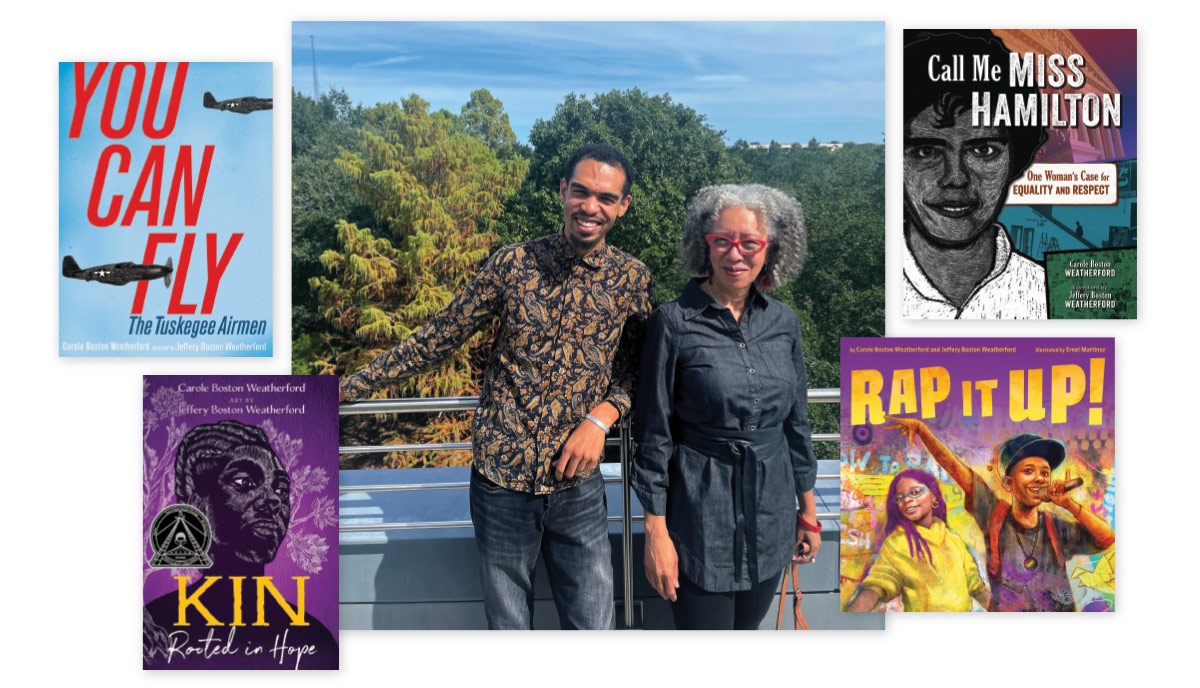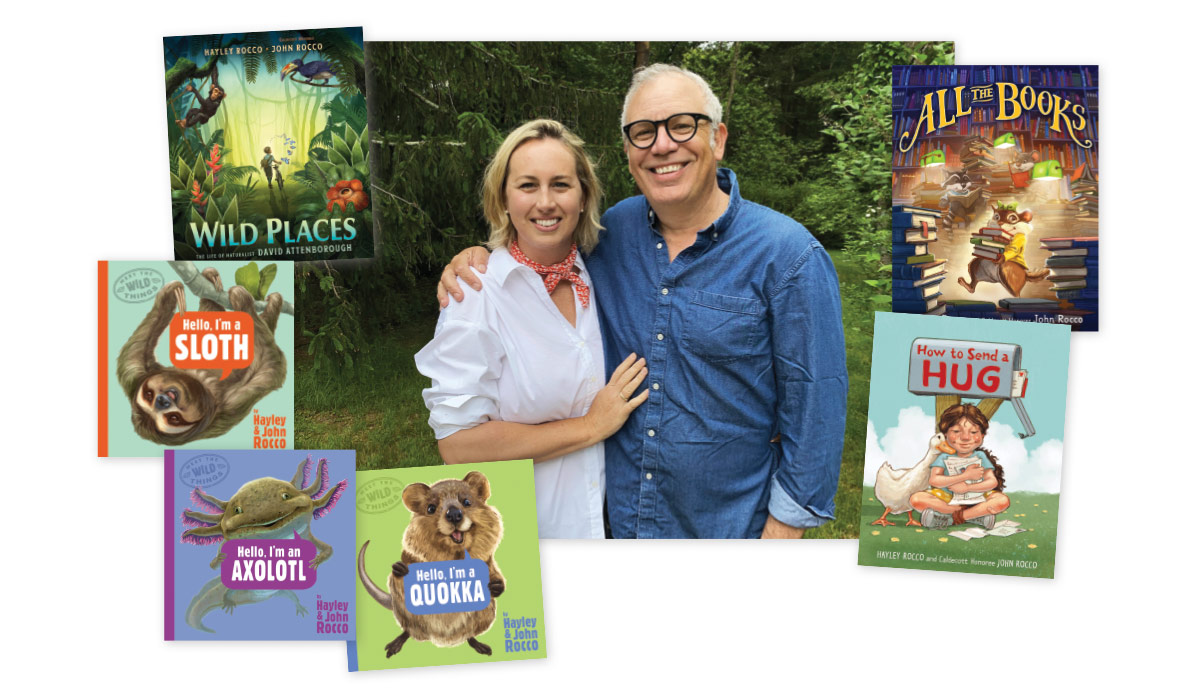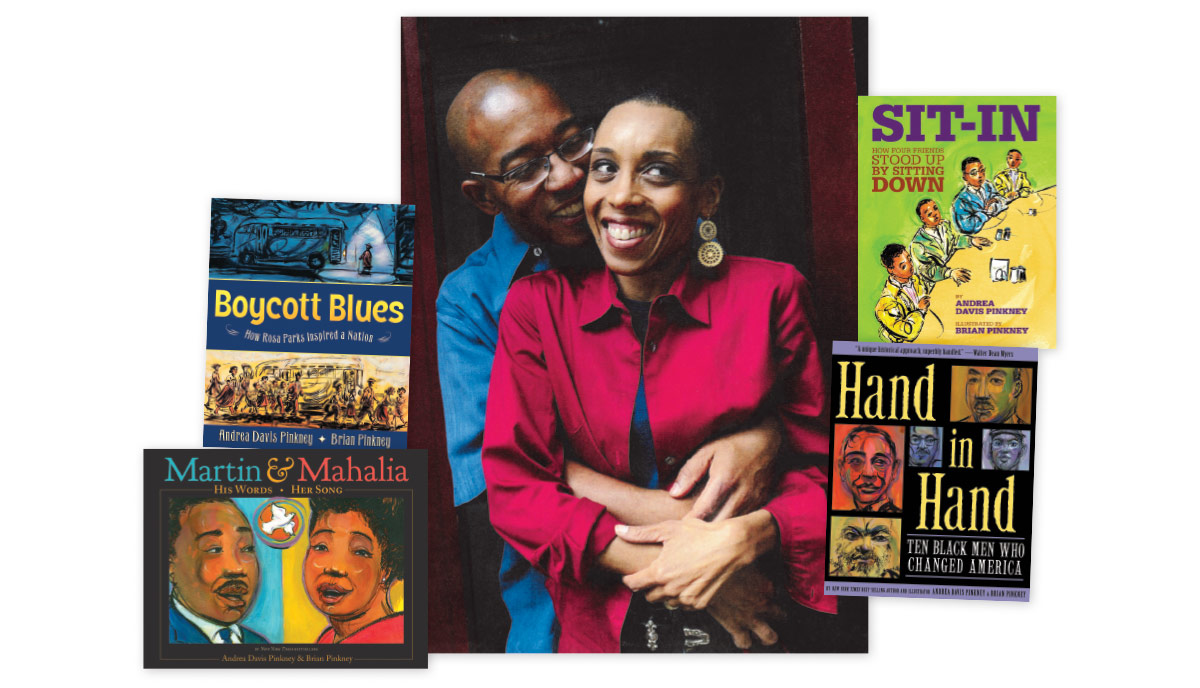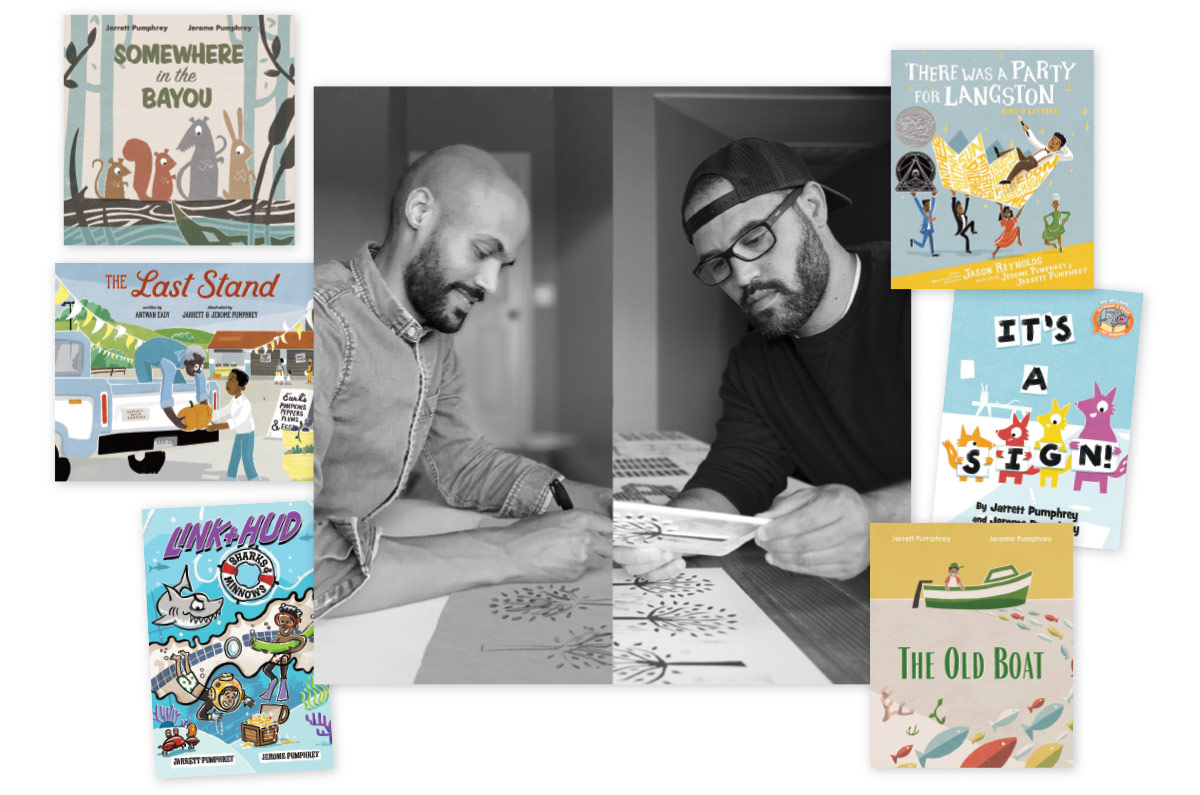The Family Business: Kid Lit Duos
Family members who collaborate talk about the dynamics (and ground rules) of their creative partnerships.


Any collaboration can be challenging. Pair that teamwork with a family member, and a whole new dynamic opens up. In short, you never know what will happen.
Many married couples have drawn on their collective creativity to produce outstanding children’s literature. The illustrators Leo and Diane Dillon worked together for more than 40 years, winning two Caldecott Medals in the 1970s for their collaborative picture books Why Mosquitoes Buzz in People’s Ears and Ashanti to Zulu: African Traditions (both Dial, 1975, 1976). Alice and Martin Provensen illustrated more than 40 books together, including 1982 Caldecott Honor title A Visit to William Blake’s Inn (Harcourt Brace, 1981) and the 1984 Caldecott winner The Glorious Flight (Viking, 1983), which they wrote and illustrated.
Some recent award-winning partnerships also include married teams (such as Nicola and David Yoon and Kevin Henkes and Laura Dronzek), as well as siblings (such as Jennifer and Matthew Holm) and parent-child duos (including the late Mary Ann Hoberman and her son, Perry).
Familial collaboration can have its benefits—such as proximity, shared mindset, and a live-in editor. But those benefits can also bring distinct challenges. How do these creative partners make it work over time? Here, four such duos—Carole Boston Weatherford and her son, Jeffery Boston Weatherford; spouses John Rocco and Hayley Rocco and Brian Pinkney and Andrea Davis Pinkney; and brothers Jarrett Pumphrey and Jerome Pumphrey provide insight on their process. These partners had a lot to say (times two), and their insights and comments provide lessons for collaboration of all types.
[Also read: A Rom-Com Dream Team: Gene Luen Yang, LeUyen Pham, and ‘Lunar New Year Love Story’ | The 2024 Stars Issue]
Carole Boston Weatherford is known for her myriad accomplishments as a children’s poet and author, with numerous awards and accolades to her name, including a 2022 Caldecott Honor for Unspeakable (Lerner/Carolrhoda, 2021), illustrated by Floyd Cooper. But she is also immensely proud of her collaboration with Jeffery on four books and counting.
How did it start? A motherly suggestion to illustrate a manuscript as a summer activity to keep Jeffery away from video games helped nurture his career in book illustration. Now Jeffery is a visual and spoken word artist, performing and exhibiting globally. Collaboration is a way of life for this duo: as Carole says, “We are The Weatherfords now.”


When John and Hayley Rocco met and got married, John was already established as a children’s book illustrator and Caldecott Honor recipient for Blackout (Little, Brown, 2011). Hayley had a career in publishing and a passion for writing books. Their first book together, How to Send a Hug (Little, Brown, 2022), amplifies the power of a letter sent through the mail—a throwback in today’s instant message culture. Since then, the Roccos have continued to collaborate on projects, including the recent All the Books (Little, Brown, 2024). They also focus on giving back through their organization Children’s Book Creators for Conservation, which brings authors and illustrators on research trips to support literature about nature and the natural world.
The Pinkneys are a household name in children’s literature circles, and for good reason. Book creation is quite literally in their blood, with the legendary illustrator Jerry Pinkney mentoring his son, Brian, into the profession. When Andrea and Brian married, they knew they could use Andrea’s writing skills and Brian’s artistic gifts in a collaborative way. Their books have won numerous awards, including a 2013 Coretta Scott King Author Award for Hand in Hand: Ten Black Men Who Changed America (Little, Brown, 2012) and the 2019 Lee Bennett Hopkins Poetry Award for Martin Rising: Requiem for a King (Scholastic, 2018).
Brothers Jarrett and Jerome Pumphrey made a name for themselves as creative partners starting with The Old Truck (Norton, 2020). Collaborators since childhood, they have published eight books together, including There Was a Party for Langston (Atheneum/Caitlin Dlouhy, 2023) written by Jason Reynolds, which earned a 2024 Caldecott Honor and Coretta Scott King Illustrator Honor. They illustrate and write books together, and whether they’re living in the same city or across the country from each other, their partnership is grounded in creative projects pursued since childhood.
Getting started…and keeping it going
How did these particular partnerships begin? Jarrett and Jerome found their creative spark as kids; as teenagers, they submitted a manuscript for publication and it was accepted (Creepy Things Are Scaring Me, Harper Collins, 2003). While the Weatherford’s collaboration began when Jeffery tried his hand at illustrating You Can Fly (S. & S., 2016), Carole says, “He was always artistic. He was born with what my mother claimed were large hands, and she knew he was going to do something really important with those hands.”
The Rocco’s inspiration came from Hayley’s passion for letter writing, coupled with John’s skills as an illustrator. And for the Pinkneys, Andrea saw a need for more books about Black children from her work as the senior lifestyle editor for Essence magazine, where she was charged with writing a column on children’s books. A little encouragement from Brian convinced her that she could be the one to write those books.
Kicking off the process is one thing, sustaining it is another. Family collaborators often work differently than other paired authors and illustrators. If nothing else, it’s typical for authors and illustrators to never meet and to work separately on their responsibilities. With family members, there’s often no sequestering. As Andrea Davis Pinkney says, “We have a unique situation, which is that I share a box of cereal and a tube of toothpaste with the guy who is illustrating my book.”


Says Carole Boston Weatherford, “This is our family business. So it is not like when Jeffery was a kid, and I would ask, ‘Have you made up your bed?’ or say, ‘You need to pick up those clothes on the floor before you go outside and ride your bike.’ I ask these questions for business reasons. I think we have worked out a good working relationship and understanding.”
The Pinkneys have had 35 collaborative years to figure out their approach. “The secret sauce that has worked for us is that we have a meeting once a week,” Andrea explains. “It is on a Saturday afternoon for about three hours.”
This idea evolved after years of trial and error, when discussions of work were dominating even family road trips. Once they developed the Saturday routine, they were both able to have boundaries between family life and professional life.
In addition, Brian says, “Language is very important in our collaboration in our family.” When offering feedback on each other’s work, they have strict rules about how the feedback should begin. Brian must always say to Andrea, “Honey, you are off to a great start.” Andrea, when providing constructive feedback on Brian’s art, must say, “Honey, it looks a little unresolved.” Andrea explains, “Really, we are just granting each other basic courtesy. And, this kind of communication can work in so many different contexts, like when you are cleaning out the garage together, for example.”
The Pinkneys respect these boundaries over the week. “When the Saturday meeting is finished, that’s it,” says Andrea. “I can’t be brushing my teeth later and add another thing to the discussion.” Brian added that Andrea keeps a list of “honey-do” items, like taking out the garbage, and a list of professional items, titled “B.P.,” for Saturday. Their working relationship is like a dance, Brian says.
[Also read: "Neal Shusterman, Dystopian Optimist"]
Snafus occur—like the time Andrea was bringing home an original cover illustration that Brian had created of Ella Fitzgerald and lost it on the subway. Miraculously, another passenger returned it. “The lesson for us as a couple—other than don’t entrust your wife with original art while she’s traveling during rush hour—is that, like a speeding subway train, our love always brings us home with a smile!” says Andrea.
The Roccos share a studio space, and their biggest working challenge is “turning it off. We are together all the time,” says Hayley. “I am the type of person who likes to talk things out as I think of them, so I will just start sharing my ideas right away.” As for John, once he gets into a rhythm on a project, he doesn’t always want to stop to talk about new ideas.
So how do they find the right rhythm? “We are working on a new system where she puts a little Post-it note on my computer that says ‘action items,’ ” says John. “When I have a little break, I can jump on those things.” Though it can be a challenge to settle on boundaries when one lives with their collaborator, Hayley says, “It also has its bonuses. We are always available to talk through new ideas together whenever inspiration strikes.”
The Pumphreys began their career in a shared studio in Jarrett’s home. But when Jarrett moved, they had to learn how to collaborate across the miles. The brothers use stamp art to create their layered illustrations. They sketch the images, then draw them onto foam, cut the foam, paste the shapes onto foam-core board, and use black paint to stamp the images and create the prints. Then the prints are scanned into a computer for digital composition, coloring, and final details.
After Jarrett moved, Jerome made stamps and mailed them to Jarrett, who created prints and sent them to Jerome for digital coloring. Currently, they live in the same town again. But they can apply the long-distance lessons to other projects—like co-illustrating There Was a Party for Langston. “Working with authors like Jason shows the collaborative effort that really goes into making a great picture book,” says Jerome. “We all had to work together to create the book we wanted. It made the work better.”


Paying it forward
So what advice can these creators offer on the subject of collaboration? According to the Roccos, patience is key. “We have such different work styles. I can be all over the place, and he can be so focused,” says Hayley. “It is great to have someone so supportive and encouraging and who believes in my abilities, but we have to have patience with one another’s differences.”
Weathering uncertainty is also key. In Costa Rica researching Hello, I’m a Sloth (Putnam, 2024), the Roccos spent days searching national parks for wild sloths and found none. When they checked into an Airbnb, the host said, “You can get a pretty good look at a two-toed sloth who’s currently slumbering in its favorite palm tree right behind you.” Hayley says, “We may or may not have jumped for joy right then and there!”
The Pumphreys encourage partners to value their shared experience and what each brings to the process. “When we started out, we placed a lot of importance on everything we shared, from our childhood experiences to the experiences we shared as adults,” says Jarrett. “Now, we see how our differences are also important to what we create.”
Those differences can come down to opinions on creative details that can yield a big impact. “I recall more than one heated debate about the placement of certain clouds in The Old Truck,” says Jarrett. “You wouldn’t think that deciding where to put a cloud would warrant more than a couple minutes discussion, but these were very important clouds. I’ve since learned that Jerome is a master of composition and layout. If he says a cloud should move over two inches, I should just trust him.”
The Pinkneys emphasize that what works for them may not work for every duo. “Each couple strikes their own bargain,” says Andrea. “I try to say nothing and do a lot of it. We try to trust each other’s creative process.” Brian adds, “And remember that the professional process might be different than the marriage process. They can be two different things.”
Researching Kin (Atheneum, 2023), a poweful exploration of their ancestors through enslavement and freedom, was an extraordinary experience for the Weatherfords. “My mom has been taking me to the area our ancestors founded since I was a baby and telling me stories about our family for as long as I can remember,” Jeffery says. “Every image and every story is a nugget of gold that our family now has back in our possession. Reclaiming your past is like gaining a treasure map that directs your future.”
The Weatherfords learned that “our ancestors were enslaved in colonial America; tutored young Frederick Douglass; served in the U.S. Colored Troops; co-founded all-Black, Reconstruction-era villages; and, according to local lore, descended from African royalty,” Carole says. “Most importantly—at a time when Black history is under attack—we came to understand that knowing your history is generational wealth.”
“The books we’ve created together would not be the same without our family collaboration, especially when they relate to our shared history.”
All photos courtesy of the author/illustrators unless otherwise noted.
Mary-Kate Sableski is an associate professor at the School of Education and Health Sciences, University of Dayton.
RELATED
The job outlook in 2030: Librarians will be in demand
The job outlook in 2030: Librarians will be in demand
ALREADY A SUBSCRIBER? LOG IN
We are currently offering this content for free. Sign up now to activate your personal profile, where you can save articles for future viewing






Add Comment :-
Be the first reader to comment.
Comment Policy:
Comment should not be empty !!!